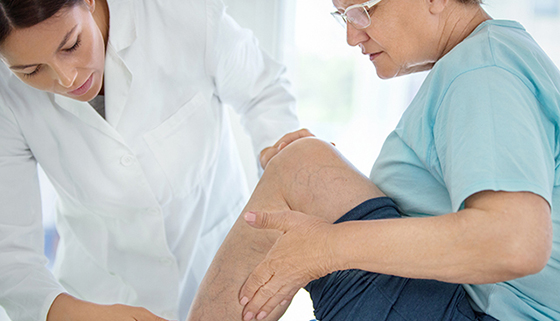Percutaneous Transluminal Angioplasty
Percutaneous Transluminal Angioplasty
(Endovascular therapy for peripheral arterial disease and claudication)
Percutaneous Transluminal Angioplasty: What You Need to Know
- Percutaneous transluminal angioplasty, in which a balloon inside the artery inflates at the site of a fatty clog to press it against the artery walls, allows the blood to flow again.
- Percutaneous transluminal angioplasty, stenting and atherectomy are minimally invasive (endovascular) procedures that restore blood flow when arteries are clogged due to peripheral artery disease.
- Stenting, in which a tube is placed in the artery to hold it open, is often part of the angioplasty procedure.
- Atherectomy, in which a device helps clear away plaque, is sometimes part of the angioplasty procedure.
Peripheral artery disease (PAD), sometimes known as peripheral vascular disease (PVD), is a blockage of arteries in a limb, usually the leg. The blockage is most often the result of a chronic buildup of hard, fatty material (atherosclerosis) inside the artery walls. This narrows the artery and prevents oxygen and nutrients from getting to the limb.
What is percutaneous transluminal angioplasty?
Percutaneous transluminal angioplasty is a minimally invasive procedure used to open a blocked artery. Your physician will follow this procedure:
-
A small incision (cut) is made in the thigh, allowing access to the femoral artery.
-
A guide wire is inserted into the artery.
-
Under the guidance of X-ray video (fluoroscopy), the wire is threaded to the site of the blockage.
-
A thin tube called a catheter sheaths the wire and is pushed to the blockage. The catheter has a small, collapsed balloon at its tip.
-
The catheter enters the blockage, and the balloon is inflated, flattening the plaque against the artery walls.
-
The balloon may be coated in medicine that helps the artery heal from this process with less scarring. This is called a drug-eluting balloon.
-
Your physician then collapses the balloon and withdraws the catheter.
-
Your physician may then perform stenting and/or atherectomy.
Percutaneous Transluminal Angioplasty Procedure and Recovery
-
The procedure will take place under local anesthesia (numbing of the incision site).
-
Whether you stay in the hospital will depend on several factors, including your condition and other tests and procedures being done.
-
Your physician will have specific orders about physical activity after you go home.
-
It’s very important to take the medication your physician prescribes to prevent more blockages.
-
You will need to return for follow-up to confirm that no new blockages have formed.
-
At some point in the future, the surgery may have to be adjusted or repeated.
What is a stent?
A stent is a mesh tube placed inside an artery to hold it open. If performed, stenting takes place just after the angioplasty balloon is used.
-
The catheter is withdrawn from the artery, and its balloon tip is loaded with the collapsed stent.
-
The catheter delivers the stent to the area of former blockage.
-
Your doctor inflates the balloon, causing the stent to expand.
-
When the balloon is collapsed, the stent remains in place.
-
The catheter and guide wire are removed.
The mesh of the stent may be covered in synthetic fabric. It may also be coated in medicine that helps the artery heal with less scarring. This is called a drug-eluting stent.
What is atherectomy?
Atherectomy is the process of de-bulking — removing some of the plaque from a blockage. If performed, it takes place just before the angioplasty balloon is used.
There are several different types of atherectomy procedures.
-
Rotational atherectomy
-
A football-shaped bead (burr) coated in tiny diamond chips is placed on the catheter.
-
At the blockage site, the burr spins, grinding the plaque into microscopic particles.
-
The particles are disposed of by the body.
-
-
Directional atherectomy
-
A hollow bead with a small opening is placed on a catheter balloon.
-
At the blockage site, the catheter balloon inflates, pushing the device’s opening toward the plaque.
-
The plaque is pressed into the opening
-
The opening has a sliding door. When the door closes, the plaque is cut off and safely stored inside the chamber.
-
-
Laser atherectomy
-
A small laser is placed on the catheter.
-
The laser tunnels through the blockage, vaporizing the plaque in its path.
-
What are other treatments for PAD (PVD)?
Other treatments for peripheral artery disease include diet, exercise and medication to combat atherosclerosis, and open bypass surgery.
Avoiding Leg Amputations Due to Peripheral Arterial Disease | Q&A
Johns Hopkins vascular surgeon Thomas Reifsnyder discusses symptoms, diagnosis and treatment of severe peripheral arterial disease. He also shares insight on how to avoid limb amputations.






